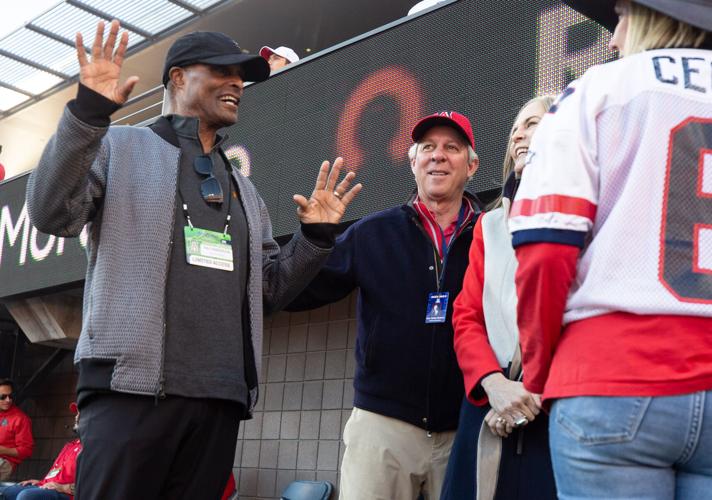Now in its second year, the Pac-12’s pursuit of a media rights agreement that will ensure the conference’s survival faces an unofficial deadline while undergoing a power shift at the presidential level.
For the first time since the saga began last summer, the so-called Four Corners schools have a seat on the board of directors’ executive committee: Arizona president Robert Robbins began his three-year term on the agenda-driving group on July 1.
Meanwhile, the conference faces a fast-approaching, albeit informal, deadline.

ASU athletic director Ray Anderson, left, greets Arizona president Robert C Robbins during the Arizona State-Arizona football game in Tucson last year. UA and ASU, along with Utah, agreed to leave the Pac-12 and join the Big 12 starting with the 2024-25 academic and sports calendar.
Its mid-summer media showcase, designed to promote the players and coaches powering the most anticipated football season in years, is scheduled for July 21 at Resorts World Las Vegas.
If commissioner George Kliavkoff doesn’t provide clarity on the contract negotiations over the next 10 days, the existential crisis could dominate the Las Vegas event and create unseemly optics.
(The tangible impact of not having a media deal in place by July 21 would be negligible, however. The Pac-12’s negotiating partners are discussing deals worth hundreds of millions of dollars annually and don’t care about bad press from a single media event.)
How should Pac-12 fans define clarity on the negotiations?
The conference doesn’t need to unveil a finalized long-form contract, which could take months to complete. But it cannot simply offer another “statement of unity” from the presidents, akin to the one issued in February. Nor can it hide behind optimistic but vague comments by Kliavkoff.
After so many months of silence, it must offer concrete evidence that a satisfactory deal is on the table and resolution is close on three tracks:
The media rights contract. The annual valuation matters immensely, but so does the means of delivery. How many football games will be placed on a streaming platform and how many will be available on linear television?
The grant-of-rights agreement. There is no collective security without this document, which is signed by the schools and binds their media revenue to the conference. (The Pac-12 likely is targeting a medium-term agreement that covers five or six years.)
The decision on expansion. Should the conference add two members — SMU and San Diego State are the favorites — or move forward with 10?
USC and UCLA are not involved in strategic matters that impact the conference beyond the 2023-24 school year, so presidential approval on media rights and expansion will require eight of 10 votes. (The grant-of-rights deal must be signed by every school, thus requiring unanimous agreement.)
Which brings us back to the Pac-12’s board of directors and two notable changes on July 1:
Washington State president Kirk Schulz took over as board chair from Washington’s Ana Mari Cauce, whose term expired.
Robbins, the Arizona president, joined Schulz and Stanford’s Marc Tessier-Lavigne on the executive committee (in the spot previously occupied by Cauce).
The move creates better geographic balance by giving the Four Corners schools, the quartet of universities being wooed by the Big 12, a presence on the influential body.
What’s more, Robbins has vastly more passion for college sports than does Cauce. In fact, the executive committee now features perhaps the two most sports-savvy presidents in the conference, Robbins and Schulz. (The latter serves as the Pac-12’s representative on the College Football Playoff’s board of managers.)
Of course, none of the board-level developments alter the fundamental calculation in this 53-week-old saga: If Kliavkoff doesn’t present a satisfactory media rights offer to the presidents — one that offers enough annual revenue and linear-network exposure — the conference could fracture.
At some point in the next 10 days, perhaps, we will have clarity on the endgame.
Can Georgia make history and win its third consecutive title? The Bulldogs are the frontrunners, but Alabama and Ohio State aren’t far behind.






